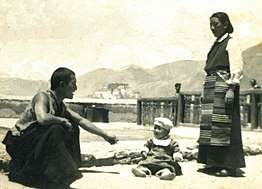Jamyang Norbu
Jamyang Norbu (Tibetan: འཇམ་དབྱངས་ནོར་བུ་, Wylie: 'jam-dbyangs nor-bu) is a Tibetan political activist and writer, currently living in the United States, having previously lived for over 40 years as a Tibetan exile in India.
Jamyang Norbu | |
|---|---|
 | |
| Born | 1949 |
| Known for | Activist for Tibetan independence |
| Spouse(s) | Tenzing Chounzom |
| Children | 2 |
Biography

Norbu attended St. Joseph's School in Darjeeling, India.[1] As a teenager, he dropped out of school[2] and ran away from home to join the Tibetan guerrilla group Chushi Gangdruk, which operated from Mustang in Nepal.[3] He was the creator of Tibetans-in-exile taxation system, or the Green Book, which has helped fund the exile government since 1972.[1] Later he founded and directed the Amnye Machen Institute, Tibetan Centre for Advanced Studies, in Dharamsala.[4]
Politics
Jamyang Norbu has been called a "radical Tibetan separatist" by the People's Daily.[5] His advocacy for complete Tibetan independence and criticism of the nonviolent "Middle Way" autonomy plan of the Central Tibetan Administration has led him to push for more "confrontational" methods.[2]

Jamyang Norbu is also critical of the role of religion in the Tibetan exile community,[6] and of its Western benefactors who, he argues, see Tibetans one-dimensionally.[7] He calls the "New Age perception of Tibet... that this even materialist west will be saved by the spiritualism of the Tibetan Buddhists" "total nonsense."[8] He said of a scene from the American film Seven Years in Tibet where Tibetan monks rescue earthworms from a construction site, that Tibetan viewers would find it ridiculous.[9] In a 2005 article for the New Humanist, he recalled an outbreak of rabies in 1983 Dharamsala: when he advocated that a Tibetan woman get a rabies shot instead of seeing a shaman, he was shunned in the community as a "nonbeliever." He lamented, "We are frankly, a people still in thrall to ignorance and superstition, which far from declining with the years seems to be gaining new life and impetus with foreign sponsorship and encouragement."[6]
Writings
Norbu has written several books and theater pieces in English and in Tibetan. Illusion and Reality, a collection of his political essays, was published in 1989.[4] In 2000 he received the Hutch Crossword Book Award for The Mandala of Sherlock Holmes. The book was published in the U.S. in 2001, first under the title Sherlock Holmes - The Missing Years, and fills in the gap in 1891 when Arthur Conan Doyle temporarily killed off Holmes. In the book, Holmes joins Huree Chunder Mookerjee, another fictional spy who last worked for the English in Rudyard Kipling's Kim.[10][11]
He has written many book reviews, including that of Professor Grunfeld.[12]
In 2011, he participated in the International Writing Program (IWP) Fall Residency at the University of Iowa in Iowa City, IA.[13]
Books In English by Jamyang Norbu
- Buying the Dragon's Teeth, High Asia Press, 2004, ISBN 0-9755371-0-5
- Warriors of Tibet: The Story of Aten and the Khampas' Fight for the Freedom of Their Country (originally titled Horseman in the Snow), Wisdom, 1987, Wisdom Pub., ISBN 0-86171-050-9.
- The Mandala of Sherlock Holmes, Bloomsbury USA, 2003, ISBN 1-58234-328-4.
 Author, blogger and activist Jamyang Norbu spoke to hundreds of Tibetans and supporters at a protest in front of the Chinese Embassy in 2011.
Author, blogger and activist Jamyang Norbu spoke to hundreds of Tibetans and supporters at a protest in front of the Chinese Embassy in 2011. - Illusion and reality, Tibetan Youth Congress, 1989.
References and notes
- "About the author". World Council of Tibetans for an Independent Tibet. Archived from the original on 2007-12-31. Retrieved 2010-09-06.
- Vembu, Venkatesan (2008-05-06). "'Dalai Lama's 'Middle Way' has failed'". Daily News & Analysis. Retrieved 2010-09-06.
- Tsering, Topden (2005-07-24). "'Hands off' isn't enough for Tibet: Dalai Lama stops short of autonomy". SFGate.com. Hearst Communications. Retrieved 12 May 2010.
- "AMI - About the People". Amnye Machen Website. Archived from the original on 3 September 2011. Retrieved 20 May 2010.
- "Tibetan separatist exposes Dalai Lama's "democracy myth"". China Tibet Information Center. People's Daily. 2009-10-21. Retrieved 2010-09-06.
- Norbu, Jamyang (July–August 2005). "Trapped by buddha". New Humanist. Vol. 120 no. 4. Retrieved 2010-09-06.
- Norbu, Jamyang (2008-06-23). "IT'S NOT THE ECONOMY, STUPID!". phayul.com. Archived from the original on 2011-06-09. Retrieved 2010-09-06.
- "jamyang norbu". Dreams of Tibet. Frontline. 1994. Retrieved 2010-09-06.
- Abramson, Mark (Summer 1998). "Mountains, monks, and mandalas: 'Kundun' and 'Seven Years in Tibet.'". Cineaste. Vol. 23 no. 3. pp. 8–12. Retrieved 2010-09-06.
- Tracey, David (2002-03-28). "Tibetan Sherlock shakes up the movement". New York Times. Archived from the original on 6 December 2011. Retrieved 12 May 2010.
- Namgyal, Tsering (2001-10-19). "Longing for the Himalayas". The Wall Street Journal. Retrieved 12 May 2010.
- Norbu, Jamyang (August 18, 2008). "Acme of Obscenity - Tom Grunfeld and The Making of Modern Tibet". TibetWrites.org. Archived from the original on July 4, 2010. Retrieved October 24, 2012.
- "2011 Resident Participants | The International Writing Program". iwp.uiowa.edu. Retrieved 2017-04-12.